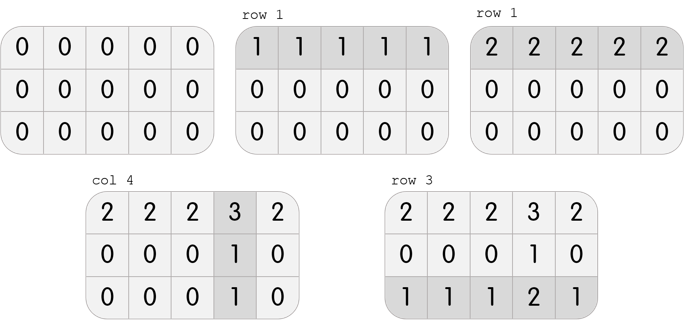C. Karen and Game
On the way to school, Karen became fixated on the puzzle game on her phone!

The game is played as follows. In each level, you have a grid with n rows and m columns. Each cell originally contains the number 0.
One move consists of choosing one row or column, and adding 1 to all of the cells in that row or column.
To win the level, after all the moves, the number in the cell at the i-th row and j-th column should be equal to gi, j.
Karen is stuck on one level, and wants to know a way to beat this level using the minimum number of moves. Please, help her with this task!
The first line of input contains two integers, n and m (1 ≤ n, m ≤ 100), the number of rows and the number of columns in the grid, respectively.
The next n lines each contain m integers. In particular, the j-th integer in the i-th of these rows contains gi, j (0 ≤ gi, j ≤ 500).
If there is an error and it is actually not possible to beat the level, output a single integer -1.
Otherwise, on the first line, output a single integer k, the minimum number of moves necessary to beat the level.
The next k lines should each contain one of the following, describing the moves in the order they must be done:
- row x, (1 ≤ x ≤ n) describing a move of the form "choose the x-th row".
- col x, (1 ≤ x ≤ m) describing a move of the form "choose the x-th column".
If there are multiple optimal solutions, output any one of them.
3 5
2 2 2 3 2
0 0 0 1 0
1 1 1 2 1
4
row 1
row 1
col 4
row 3
3 3
0 0 0
0 1 0
0 0 0
-1
3 3
1 1 1
1 1 1
1 1 1
3
row 1
row 2
row 3
In the first test case, Karen has a grid with 3 rows and 5 columns. She can perform the following 4 moves to beat the level:

In the second test case, Karen has a grid with 3 rows and 3 columns. It is clear that it is impossible to beat the level; performing any move will create three 1s on the grid, but it is required to only have one 1 in the center.
In the third test case, Karen has a grid with 3 rows and 3 columns. She can perform the following 3 moves to beat the level:

Note that this is not the only solution; another solution, among others, is col 1, col 2, col 3.
题解:
这道题首先想过网络流,然而没有什么用。
后来发现贪心可以过,求出每行每列的最小值,然后一个一个找,从行开始,每次维护一下列的最小值,最后统计一下值的总合是不是和之前的相同,不是的话就说明还有残余,如样例2。是的话就输出结果。
注:这个代码有问题,正解在最下面
#include<iostream> #include<cstdio> #include<cstring> #include<cmath> #include<cstdlib> #include<algorithm> using namespace std; int s[101][101],n,m,sum,sum2; int mminn[101],mminm[101]; int ans1[101],cnt,ans2[101]; int main() { int i,j; memset(mminn,127/3,sizeof(mminn)); memset(mminm,127/3,sizeof(mminm)); scanf("%d%d",&n,&m); for(i=1;i<=n;i++) { for(j=1;j<=m;j++) { scanf("%d",&s[i][j]); sum+=s[i][j]; } } for(i=1;i<=n;i++) { for(j=1;j<=m;j++) mminn[i]=min(mminn[i],s[i][j]); } for(j=1;j<=m;j++) { for(i=1;i<=n;i++) mminm[j]=min(mminm[j],s[i][j]); } for(i=1;i<=n;i++) { ans1[i]=mminn[i]; for(j=1;j<=m;j++) { s[i][j]-=mminn[i]; mminm[j]=min(mminm[j],s[i][j]); } } for(j=1;j<=m;j++) { ans2[j]=mminm[j]; } for(i=1;i<=n;i++) { sum2+=ans1[i]*m; } for(i=1;i<=m;i++) { sum2+=ans2[i]*n; } if(sum==sum2) { for(i=1;i<=n;i++) if(ans1[i])cnt+=ans1[i]; for(i=1;i<=m;i++) if(ans2[i])cnt+=ans2[i]; printf("%d\n",cnt); for(i=1;i<=n;i++) { for(j=1;j<=ans1[i];j++) printf("row %d\n",i); } for(i=1;i<=m;i++) { for(j=1;j<=ans2[i];j++) printf("col %d\n",i); } } else cout<<"-1"; return 0; }
没错,这份代码确实有问题,很显然随便设计一组测试数据
input
4 3
1 1 1
1 1 1
1 1 1
1 1 1
output
3
col 1
col 2
col 3
而上面这份代码会输出
output
4
row 1
row 2
row 3
row 4
然后就WA掉了,(心痛)。但是修改也很简单,最后判断一下是从行还是从列开始就可以了。
#include<iostream> #include<cstdio> #include<cstring> #include<cmath> #include<cstdlib> #include<algorithm> using namespace std; int s[101][101],n,m,sum,sum2; int mminn[101],mminm[101]; int ans1[101],cnt,ans2[101]; int main() { int i,j; memset(mminn,127/3,sizeof(mminn)); memset(mminm,127/3,sizeof(mminm)); scanf("%d%d",&n,&m); for(i=1;i<=n;i++) { for(j=1;j<=m;j++) { scanf("%d",&s[i][j]); sum+=s[i][j]; } } for(i=1;i<=n;i++) { for(j=1;j<=m;j++) mminn[i]=min(mminn[i],s[i][j]); } for(j=1;j<=m;j++) { for(i=1;i<=n;i++) mminm[j]=min(mminm[j],s[i][j]); } if(m>n) { for(i=1;i<=n;i++) { ans1[i]=mminn[i]; for(j=1;j<=m;j++) { s[i][j]-=mminn[i]; mminm[j]=min(mminm[j],s[i][j]); } } for(j=1;j<=m;j++) { ans2[j]=mminm[j]; } for(i=1;i<=n;i++) { sum2+=ans1[i]*m; } for(i=1;i<=m;i++) { sum2+=ans2[i]*n; } if(sum==sum2) { for(i=1;i<=n;i++) if(ans1[i])cnt+=ans1[i]; for(i=1;i<=m;i++) if(ans2[i])cnt+=ans2[i]; printf("%d\n",cnt); for(i=1;i<=n;i++) { for(j=1;j<=ans1[i];j++) printf("row %d\n",i); } for(i=1;i<=m;i++) { for(j=1;j<=ans2[i];j++) printf("col %d\n",i); } } else cout<<"-1"; } else { for(i=1;i<=m;i++) { ans2[i]=mminm[i]; for(j=1;j<=n;j++) { s[j][i]-=mminm[i]; mminn[j]=min(mminn[j],s[j][i]); } } for(j=1;j<=n;j++) { ans1[j]=mminn[j]; } for(i=1;i<=n;i++) { sum2+=ans1[i]*m; } for(i=1;i<=m;i++) { sum2+=ans2[i]*n; } if(sum==sum2) { for(i=1;i<=n;i++) if(ans1[i])cnt+=ans1[i]; for(i=1;i<=m;i++) if(ans2[i])cnt+=ans2[i]; printf("%d\n",cnt); for(i=1;i<=n;i++) { for(j=1;j<=ans1[i];j++) printf("row %d\n",i); } for(i=1;i<=m;i++) { for(j=1;j<=ans2[i];j++) printf("col %d\n",i); } } else cout<<"-1"; } return 0; }

